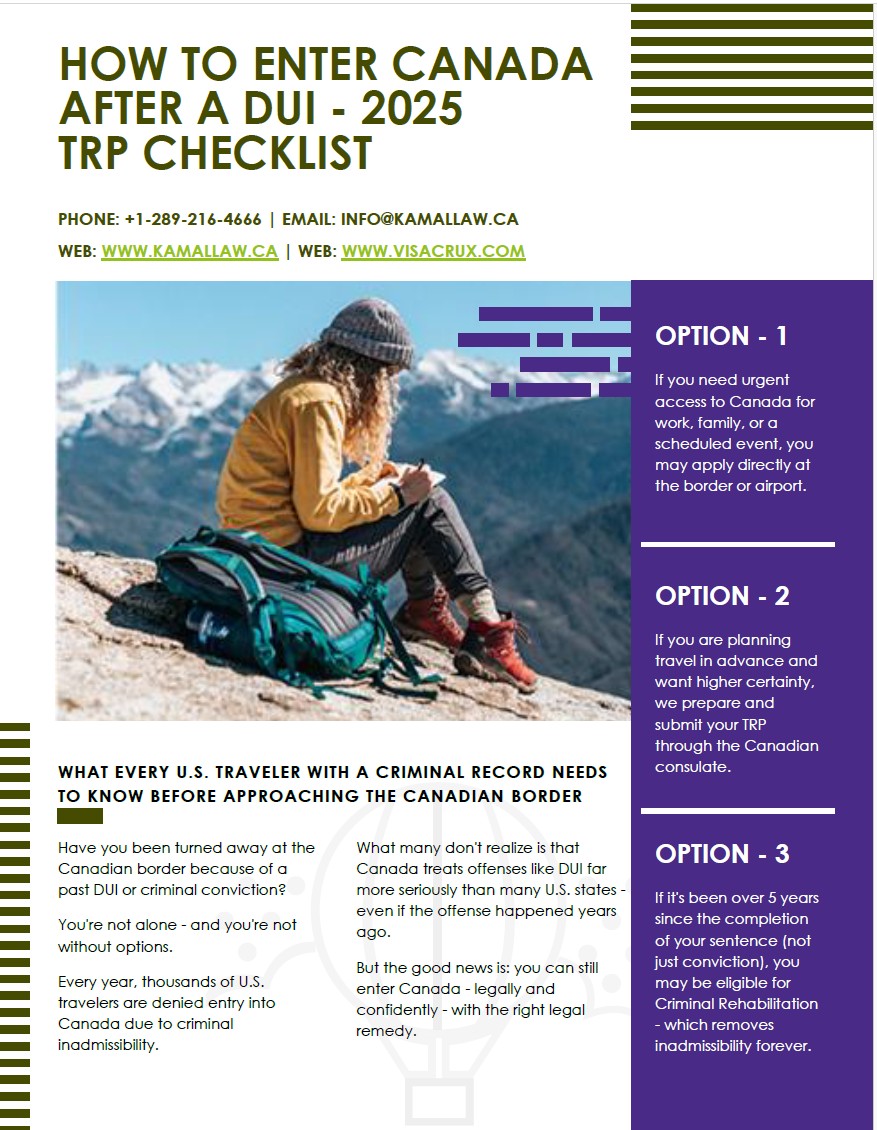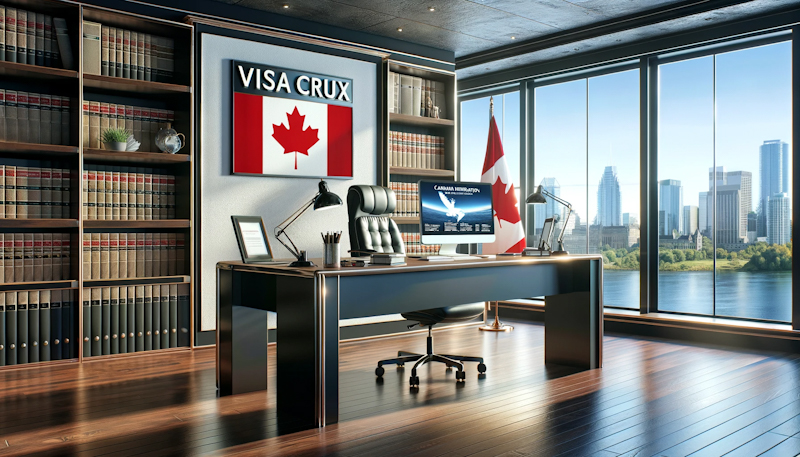You get to clarity before spending anything!
Download the TRP Guide written by a Lawyer
Kamal Akhtar, Immigration Lawyer | Dec 2025
Kamal Akhtar is a Canadian immigration lawyer licensed by the Law Society of Ontario. Based in Ontario, Canada. Kamal has years of experience helping foreign nationals with immigration applications and appeals. He specializes in Canadian immigration law and other complex entry solutions. Kamal dedicates himself to delivering honest, strategic, and client-centered legal solutions for every case.
Stay prepared, avoid surprises at the border, and know exactly what documents you need. Download this 2025 TRP Guide & Checklist PDF to make sure you never miss a critical item.
If your travel is urgent, you can call the lawyer directly at
USA Phone: +1 (289) 216-4666 | Email: info@kamallaw.ca
Are you planning to enter Canada but worried about a DUI or criminal record?
1. Apply for a Temporary Resident Permit (TRP) at the border (POE).
2. Submit a TRP application through a consulate for longer stays.
3. Prepare for Criminal Rehabilitation as a permanent solution.
Stay prepared, avoid surprises at the border, and know exactly what documents you need. Download this 2025 TRP Guide & Checklist PDF to make sure you never miss a critical item.
TRP at the Border Checklist (Canada) 2025
Every year, thousands of foreign nationals attempt to cross the Canadian border only to discover that a past criminal record, even a single criminal conviction for impaired driving, renders them inadmissible. If you are a US citizen or resident of the United States planning to visit Canada, you may suddenly find yourself blocked from entry without the proper travel documents.
Fortunately, Canada provides a legal solution: the Temporary Resident Permit (TRP). This special document allows individuals with past offenses to enter Canada temporarily, provided they demonstrate a compelling reason and satisfy strict criteria under Canadian law. But applying for and receiving a TRP is not as simple as showing up at the border. You need a complete temporary resident permit application and supporting evidence in hand.
This page provides the 2025 TRP at the Border Checklist, giving you the exact steps and paperwork to prepare in advance of your trip. It also explains why consulting a Canadian immigration lawyer, preferably one with extensive experience in TRP applications and criminal rehabilitation, dramatically increases your chances of success.
1. TRP and Criminal Rehabilitation
2. Temporary Resident Permit (TRP)
3. Criminal Rehabilitation
4. How to Enter Canada with a DUI
5. TRP for DUI (Driving Under the Influence)
6. TRP Checklist 2025 (Free PDF Download)
TRP Border Checklist (2025)
Here’s what you must bring with you:
1. Valid passport & government ID
2. Completed TRP forms (mirror IRCC’s IMM 5557 checklist )
3. Court dispositions & FBI/state police records proving all charges are resolved
4. Proof of purpose/urgency (invitation letter, medical necessity, work/employer letter, travel itinerary)
5. Evidence of rehabilitation & good conduct (employment letters, community service, character references)
6. Supporting documents (marriage certificate, proof of family ties, business documents, etc., if relevant)
7. Payment method for the TRP government fee ($200 CAD)
8. Biometrics (may be requested)
ℹ️ This checklist is based on IRCC’s official TRP document list (IMM 5557, updated Aug 8, 2025) and recent TRP processing guidance .

What Is a TRP and Why It Matters
A Canada Temporary Resident Permit is a legal document issued to foreign nationals who are otherwise inadmissible due to a criminal record or a history of a serious crime. Unlike standard visas, TRPs are issued only in exceptional circumstances. Immigration officials evaluate whether your need to enter outweighs the potential risk to Canadian society.
Key facts:
- TRPs are temporary. They may be granted for a single entry (days or weeks) or up to three years in rare case.
- They are discretionary. Officers at a port of entry (such as a land border crossing or Canadian airport) have broad authority to approve or refuse.
- They are not guaranteed. Without proper preparation, refusals are common.
TRP at the Border vs. Advance Applications
There are two main ways to apply:
1. Port of Entry TRP (same-day):
- You bring all required paperwork to a land border crossing or Canadian airport.
- A decision is made immediately.
- Advantage: Quick if you have urgent travel. Disadvantage: High refusal rate; inconsistent outcomes; no appeal process.
2. Consulate/Advance TRP Applications:
- Submitted to a Canadian visa office in advance of travel.
- Reviewed thoroughly before your trip.
- Higher success rates than same-day requests.
Most Canadian TRP lawyers recommend filing in advance of your trip, but if your travel is urgent, the border checklist below becomes critical.
✅ 2025 TRP Border Checklist
Before approaching immigration officials at the Canadian border, ensure you carry:
1. Government-issued ID and Passport
- Must be valid for the duration of your trip.
2. Completed Temporary Resident Permit Application (IMM 5708/IMM 5557)
- Always bring the official forms plus a cover letter.
3. Court Dispositions and Criminal Record Checks
- Certified records showing the outcome of each criminal conviction.
4. Evidence of Purpose of Travel
- Employer letters, family invitations, medical documents, conference registration, or proof of personal use travel (e.g., weddings, funerals).
5. Proof of Rehabilitation or Low Risk
- Certificates of rehabilitation, letters from employers, community references, proof of sobriety programs.
6. Supporting Documents
- Bank statements, travel insurance, hotel bookings, proof of ties to home country.
7. Payment Method
- TRP processing fee (updated 2025: $239.75 CAD).
8. Travel Documents for Dependents (if applicable)
- Children’s passports, custody documents, birth certificates.
📌 Pro Tip: Officers expect you to arrive with documents neatly organized in a binder or folder. Messy or incomplete submissions undermine your credibility.
Download the TRP Guide written by a Lawyer
Kamal Akhtar, Immigration Lawyer | Dec 2025
What to Expect at the Border
When you apply for a TRP at a port of entry, officers follow strict Canadian law and assess three factors:
- Necessity of Travel: Why is entering Canada urgent? (business, medical, family, etc.)
- Risk to Canada: Do your past actions indicate a future threat?
- Supporting Evidence: Are your documents strong and complete?
If your package is weak, your TRP will likely be refused, even after a long time waiting in line.
⚖️ Remember: The chances of success depend not just on your paperwork but on the professionalism of your presentation and the quality of your supporting documents.

Why Legal Representation Helps
While anyone can attempt a TRP alone, working with a Canadian immigration lawyer who has extensive experience with TRP applications significantly improves outcomes. Experienced counsel can:
- Structure your application to meet high standards set by IRCC.
- Provide persuasive legal arguments grounded in Canadian law.
- Anticipate officer concerns and address them proactively.
- Explain how a TRP fits into a long-term plan, including eventual criminal rehabilitation or even obtaining a Canadian work permit if needed.
✅ A seasoned Canadian TRP lawyer has often prepared hundreds of similar files. They know what works at a land border crossing, how to handle immigration officials, and which arguments achieve higher success rates.
Common Mistakes to Avoid at the Canadian Border
Even with a completed temporary resident permit application, many travelers make errors that reduce their chances of success. Avoid these pitfalls:
1. Arriving without complete travel documents
- Missing just one record (e.g., court disposition) is grounds for refusal.
2. Failing to prepare in advance of travel
- Officers are more sympathetic if it’s clear you organized your file well in advance of your trip.
3. Not understanding local laws
- For example, a serious crime in the United States may be treated more harshly under Canadian law.
4. Overlooking travel insurance
- Officers sometimes view lack of travel insurance as a sign you haven’t prepared responsibly.
5. Downplaying your criminal record
- Be honest. Concealment leads to permanent bans.
Land Border vs. Canadian Airport TRPs
Many people wonder whether it’s better to apply at a land border crossing or a Canadian airport.
Land Border Crossing:
- Often less formal, but officers have the same authority.
- Longer waits are common, especially during peak hours.
Canadian Airport:
- Officers tend to apply stricter scrutiny.
- Best for travelers already flying in from the United States.
In either case, officers apply high standards and evaluate based on the strength of your submission.
TRP vs. Criminal Rehabilitation
A TRP is temporary. If it has been a long time (5+ years since completing your sentence), you may qualify for criminal rehabilitation, which permanently resolves inadmissibility. Many travelers choose to:
- File a TRP for immediate entry.
- File for criminal rehabilitation simultaneously to secure long-term freedom to travel.
Linking TRP to Future Opportunities
A properly prepared TRP can open doors:
- Canadian Work Permit: Some applicants use TRP entry to later apply for a Canadian work permit, particularly if they secure a job offer.
- Family Reunification: TRPs allow parents, spouses, and children to maintain relationships while addressing inadmissibility.
- Business and Conferences: Demonstrating urgency for work reasons can improve success rates.
Success Rates and Legal Support
Statistics show that TRPs filed through Canadian immigration lawyers with extensive experience have significantly higher success rates than self-filed border requests.
Why? Because experienced lawyers:
- Anticipate officer objections.
- Ensure compliance with local laws.
- Prepare persuasive supporting letters.
- Demonstrate your commitment to high standards of conduct.
⚖️ Whether you’re a US citizen planning a weekend trip or a business traveler needing urgent access, the right legal strategy can mean the difference between entry and refusal.
6. Common Questions (FAQs)
1. Can I apply for a TRP at any port of entry?
1. Can I apply for a TRP at any port of entry?
A: Yes. Both land border crossings and Canadian airports accept TRP requests.
2. How long does it take?
2. How long does it take?
A. TRP applications at the border are same-day decisions, but you may wait a long time in secondary inspection.
3. Do I need travel insurance?
3. Do I need travel insurance?
A: It’s not mandatory, but highly recommended. Immigration officials see it as a sign of responsibility.
4. Can I enter Canada with a serious crime on my record?
4. Can I enter Canada with a serious crime on my record?
A: It depends. Canadian law distinguishes between minor and serious crime. TRPs are harder to obtain for more serious offenses, but still possible.
5. Should I apply in advance of travel?
5. Should I apply in advance of travel?
Yes. TRPs submitted in advance of your trip to a consulate generally have higher chances of success than same-day border applications.
Download the TRP Guide written by a Lawyer
Kamal Akhtar, Immigration Lawyer | Dec 2025
Final Word
Crossing into Canada with a criminal record can feel overwhelming. But with the right preparation, legal support, and understanding of local laws, your chances of success rise dramatically. Whether you’re traveling for personal use, business, or family, a complete TRP at the border checklist, prepared in advance of travel is your best ally.
If you want high standards, proven strategies, and guidance from a Canadian TRP lawyer with extensive experience, our team is here to help.
Where to Find Resources?
To stay updated with the latest rules and regulations, application processes, forms, and other details about Canada temporary resident permit TRP or rehabilitation, consider visiting this government website: Temporary resident permits (TRPs).

Kamal Akhtar is a Canadian immigration lawyer licensed by the Law Society of Ontario. Based in Ontario, Canada. Kamal has years of experience helping foreign nationals with immigration applications and appeals. He specializes in Canadian immigration law and other complex entry solutions. Kamal dedicates himself to delivering honest, strategic, and client-centered legal solutions for every case.
Kamal's credentials include a Bachelor of Law (LL.B.) and a Master of Law (LL.M.) from Osgoode Hall Law School in Toronto. Kamal is a noted member of professional associations like the Canadian Immigration Lawyers Association (CILA), the Canadian Association of Professional Immigration Consultants (CAPIC), the Canadian Bar Association (CBA), and the Ontario Bar Association (OBA). Over 20 years of legal experience shape Kamal's insights.
Please note that the information provided on this website does not constitute legal or professional advice.
Phone: +1 (289) 216-4666 | Fax: +1 (289) 778-4745 | Email: info@kamallaw.ca



